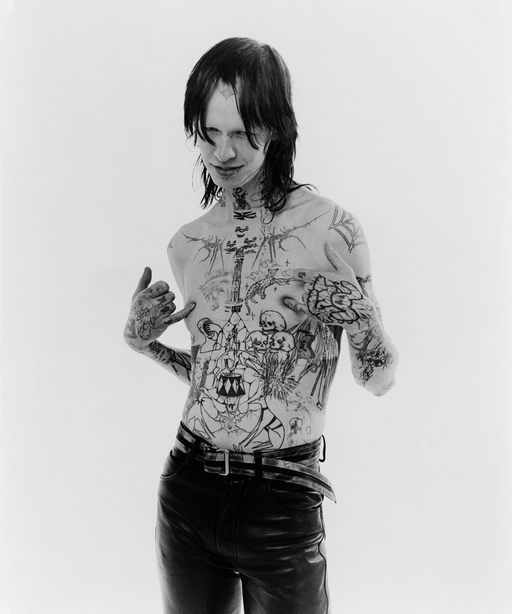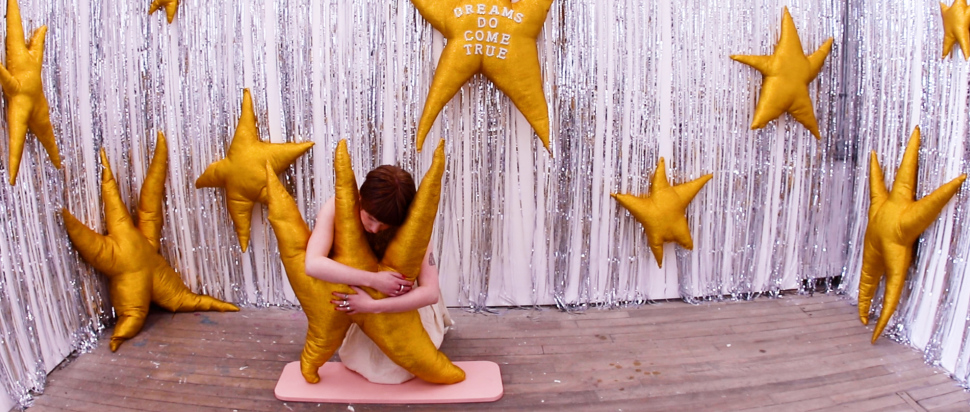GSA Degree Show 2023: School of Fine Art
Across its three disciplines, students at the GSA's School of Fine Art has produced a dynamic body of work reflective of the turbulent landscape ahead
Experimental in their approach to material enquiry, while also revisiting traditional methods of making, this year's final year Fine Art students have produced works of art that are critical yet romantic, dystopian yet hopeful.
Sculpture & Environmental Art
Sculpture & Environmental Art sees a lot of thematic overlap, with this year's students producing work which sits at the intersection of art, science and faith. Much of the work feels primordial and ritualistic, harkening to the past whilst looking forward to oftentimes dystopian-seeming futures. Perhaps this fixation on the past, both real and imagined, is the result of navigating the collective trauma of an uncertain future, which makes this body of sculptural works all the more mysterious and romantic.
Rich in quasi-religious symbology, Ditte Krøyer’s bold, monochromatic linoprints explore the parallels between the unknown of the afterlife and the crippling anxieties of our climate crisis. Installed in a sea of sheer blackness, Ditte rejects the notion of binaries, exploring liminal spaces and in-betweens which, for her, mimic the unknown of the subconscious mind.
This liminality is explored further by Lizzie Munro who presents us with work intrinsically linked with the natural world. Investigating wilderness within the city, Lizzie uses locally foraged willow and teasels to create objects which aid the crossing of thresholds. Collected from miniature ecosystems nestled off motorways and tennis courts, the materials Lizzie uses come from grey areas in terms of ownership. These in-between spaces are a politically charged no man's land which she seeks to reclaim. Woven masks and a burial chamber consider ritual, mortality and deep time, with a focus on the rhythmic embodiment of traditional methods of making.
Similarly examining space and ownership, Yolanda Sneddon’s moving image work presents us with an object reminiscent of the cityscape and the rigidity of public life in such a metropolis. Yolanda juxtaposes this coded, autonomous object of urban architecture with the stillness of the countryside, giving the work an absurdist yet eerie, post-apocalyptic feel.
Further dichotomies are explored with Nadia Zhaya’s sculpture Explosion from within, an object that simultaneously looks like an unearthed ancient artefact as well as a hyper-futuristic interplanetary tool. Nadia has created a ‘timeless capsule’ in everlasting plastics, exploring the universal and elemental through an encased explosion, eternally frozen within the plastic.
Sadie Downing’s body of work, Dreams Do Come True, laments her past experiences as a ballerina, and explores mental health through this lens. Merging kitschy aesthetics with clinical materials, Sadie comments on the precarious nature of ballet dancers' health and safety when pushed to the limits of perfection, and the homemade finish of her saccharine display possesses an insidiousness underneath the frills and fringing of pageantry.
Centred around an imagined space voyage, Max Longhurst’s work acts as a dialogue stretching through time, presenting a critical evaluation of the past and aiming to articulate a proposal for the future. Restaging a 19th Century photograph of Danish-Norwegian astronomer Sophus Tromholt, Max has preserved the theatricality of the original image, fashioning clothing and objects which appear both medieval and otherworldly.
Probing visceral and bodily reactions is the sculptural work of Breagh Reilly. Birthed from a stranger's retainer found on the street, Breagh’s work is evocative of a nightmarish dental visit complete with oversized ceramic teeth. Interested in tangible, knee-jerk reactions, Breagh investigates the somatic and abject through universal experience.
Fine Art Photography
This year's Fine Art Photography cohort have produced an impressive body of work spanning familial ties, 24/7 surveillance culture and the natural world. Collectively, they produce the feeling of examining the role of documentation in a time of crisis.
Incorporating photography, moving image and performance, Alan Bell’s work documents restriction and surveillance in contemporary culture. Capturing the textures of the cityscape in 35mm, Alan’s images spotlight the grainy shadows of the metropolis, commanding the image and manifesting as the narrators of this critique of public space. Documenting signs and semiotics, Alan explores the control we relinquish in the public domain compared to the data we surrender in cyberspace.
Documenting a landscape in flux, Nikoline Hoeberg Sonasson’s work Falljökull poignantly captures glacial melt in Iceland. Juxtaposing a charged freeze frame of slick, glossy ice with an image of a yellowing, arid environment, Nikoline creates a harrowing dialogue between the two landscapes, leaving us to think about the human impact on the space between the two.
In a similar fashion, Haneen Hadiy’s intimate project The Mother of The Motherland explores the non-human through an anthropomorphic lens, spotlighting the Iraqi date palm and its rich symbolism. Haneen’s interdisciplinary practice explores her own cultural heritage and familial history, whilst commenting on the concept of time, inviting us to ruminate Iraq’s history and status as the Cradle of Civilisation.
Fine Art Photography also sees an immersive, installation-based approach to the discipline. The antithesis of a white cube space, Heather S Roberts’ dark, khaki-toned walls speak to the dominant nature of her work. Experimenting with alternative method photography, Heather’s images are liquid emulsion darkroom prints on steel. Through these as well as moving image, sound and sculptural works, her self-portraiture explores the duality of femininity.

Aura East’s project, AFT3RF0RM (pictured above), archives Glasgow’s alternative tattoo scene with a series of intimate darkroom prints. Exhibited alongside floral sculptures which correlate with each subject, the sculptures act as an extension of each image, forming a kind of cohesive human/non-human portrait. Rejecting the singular authority of the photographer, Aura champions image-making as a collaborative process, and an accompanying phonebook showcases both the tattoo artists and the glitchy yet ornate style they are pioneering.
Shot both digitally and on Super 8 camera, Hannah Turner’s moving image work utilises archive footage from the closure of a factory where her grandfather had worked for 25 years. Weaving together family history with a wider community narrative, Hannah explores both public and private memory. Projected onto a suspended dual screen set-up, Hannah establishes a conversation through time, as the floating films mirror one another, and the past is recontextualised.
Painting & Printmaking
Finally, this year's Painting & Printmaking class have spawned a luscious and varied body of work. Through expressive mark-making and textured, dimensional work, the paintings explore acts of decadence, the impact of repetition, and humankind's entanglement with technology.
Katherine Scheibli's work is concerned with the impact of technological influences on humanity, utilising abstract, expressive marks to argue and converse with her references to Teletext and technical error. Life is a constant battle between the analogue and digital over which serves us more.
The daring painter Teodora-Silvia Modoi approaches a large canvas destined for detail and depth with enviable confidence. Teodora-Silvia depicts scenes of a dark, laborious nature and describes them with dulcet palette tones and application. Narratives of obstruction, construction and entrapment are fed to us via dark, looming skies and objects capable of causing scathing harm.
Ted Tinkler explores notions of care and sentiment in their practice, which is centred around traditional methods of craft – quilting, spinning and knitting. The integration of their work with the landscape suggests a notion of comfort in transience and personification of soft, homely, handmade material. You can imagine the material as part of a river running through rich, fertile hills and contemplate the connection humans have with land.
Poppy Pearce works paint into variable surfaces to create luscious textures which illicit velvety, illusive sentiments. These stories envelop the viewer like warm ocean waters, with figures that question your role in their scene via subtle, interrogating glances which invite without intimidation.

Misra Balkan (work pictured above) creates confident, inventive work in the expansive field of painting, permeating the notion of a two-dimensional landscape. This artist’s work leads you to believe that further debauchery lies beyond the scene in the foreground, and the wonderlands in the deep of the forest call out for our imagination to feed their existence.
Liv Fox is dedicated to handling repetition of motif and format in their work. Symbolic of versatility and material awareness, the transcription of her work in different contexts develops a language which concerns the simplicity of shape and colour, and morphs to their environment.
Cat Tams is a sensitive and vigilant observer of her environment and is gifted in her ability to apply painterly techniques – the layering of pastels and oil paint with sophisticated motion creates a lush quality. With particular attention to light, colour and form she creates an interplay between volume and surface. Capturing the influence of her environment, Cat translates it into figurative works with intellectual response.
Dora Padfield’s canvas invites a conversation with us, speaking an instinctive language through soft, felt-like marks and messages bleeding through the canvas. The paint journeys purposefully on the surface of the canvas, despite melting and dissolving within the fabric.
The School of Fine Art Degree Show runs 2-11 Jun in the Stow Building, 64 Shamrock Street, Glasgow. It is also available to view online at gsashowcase.net
